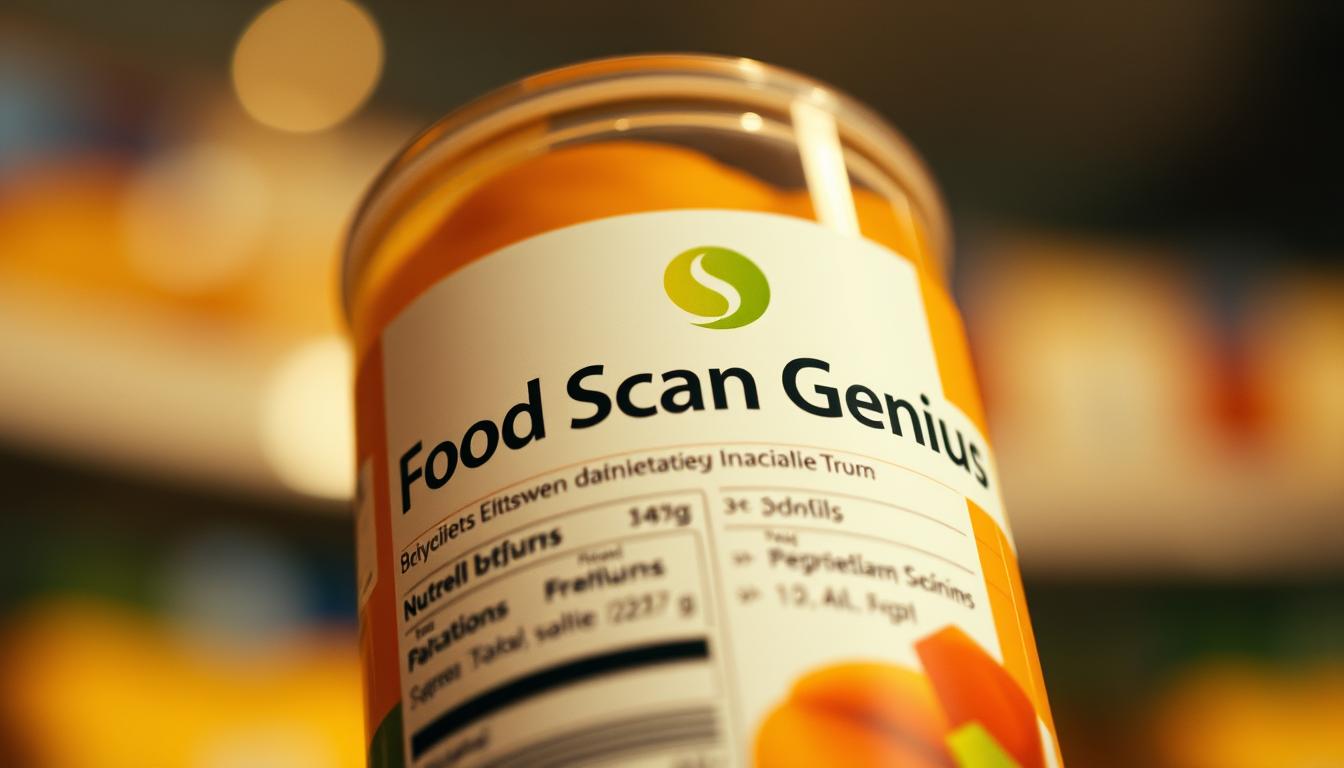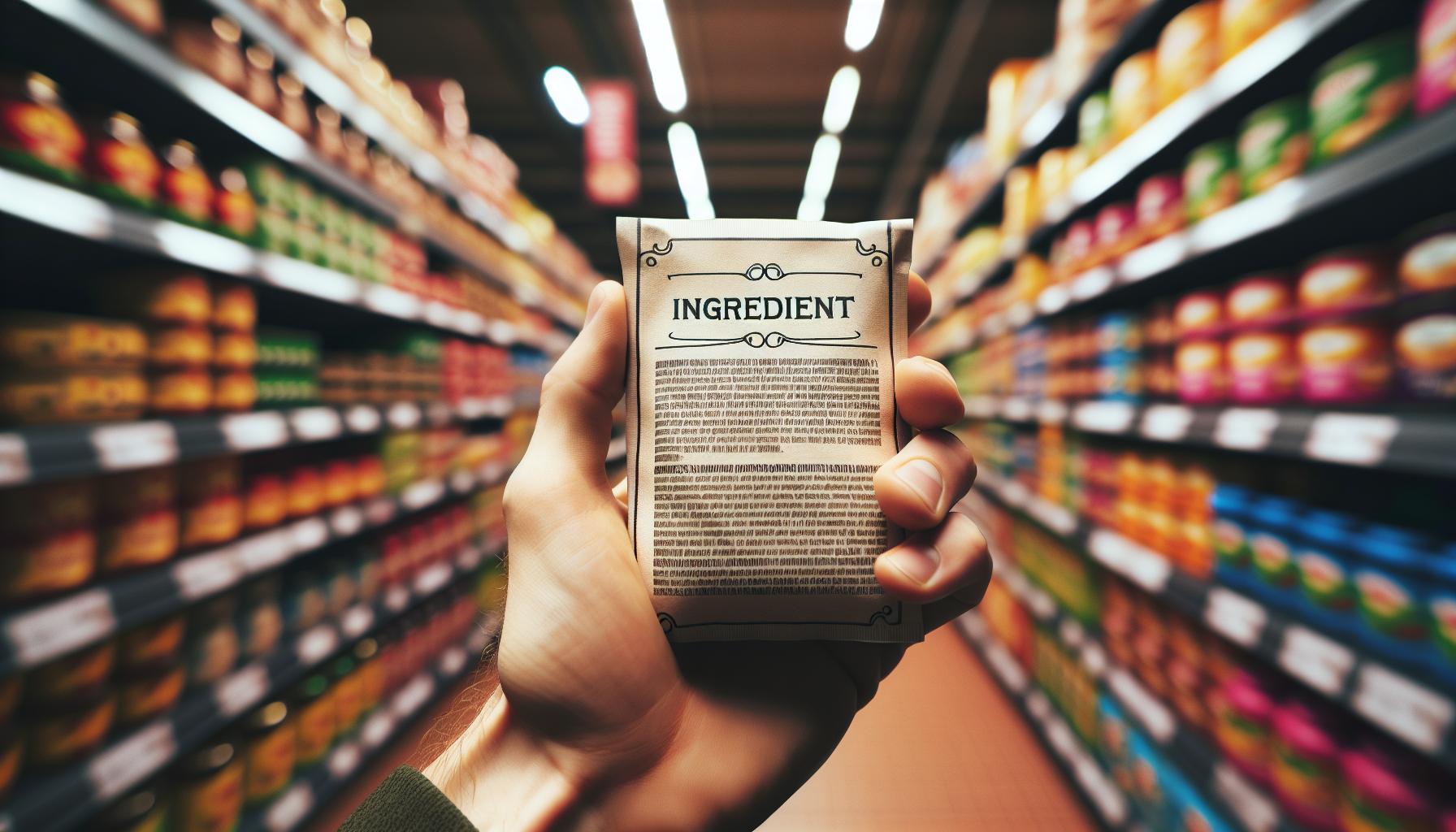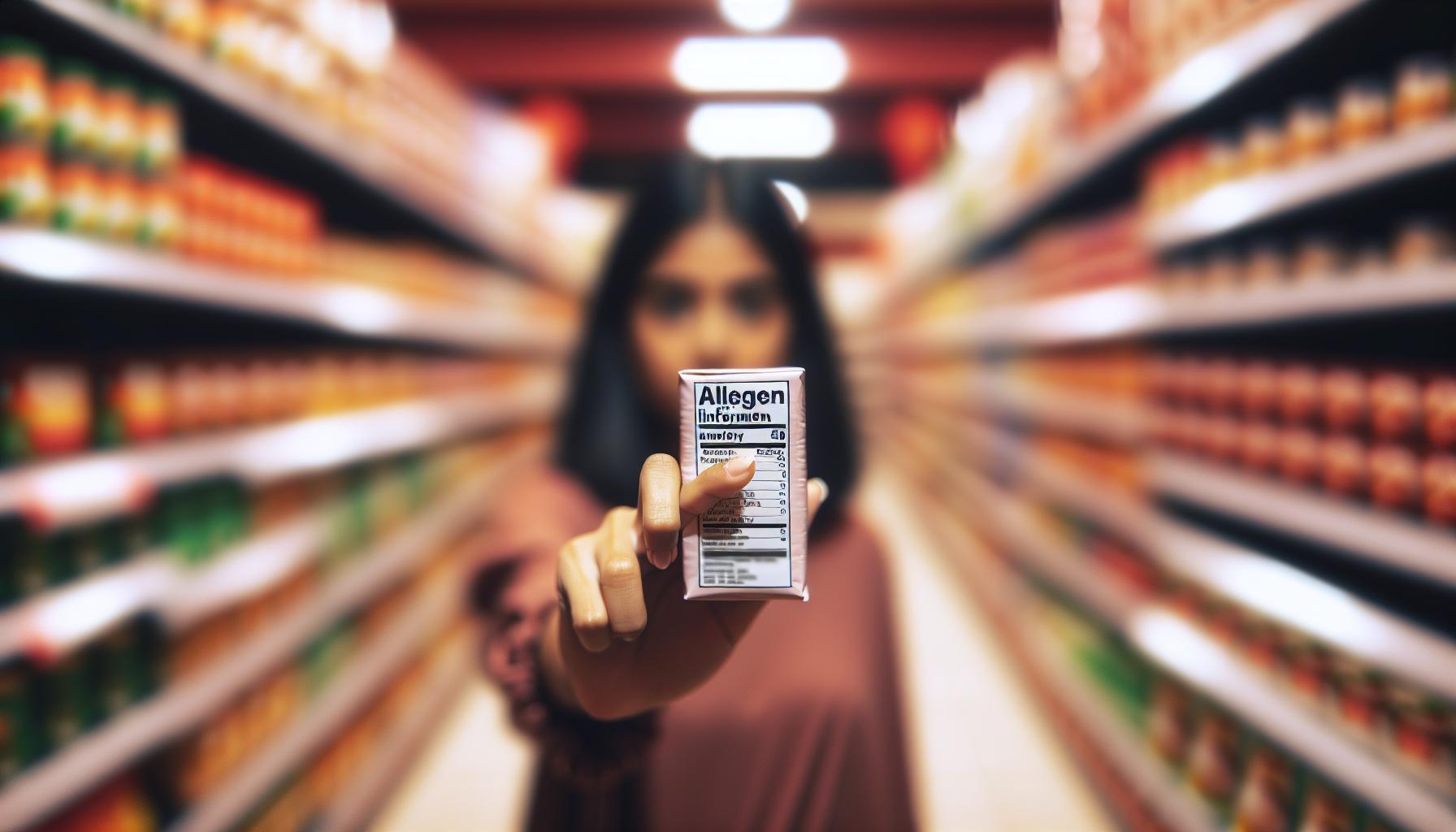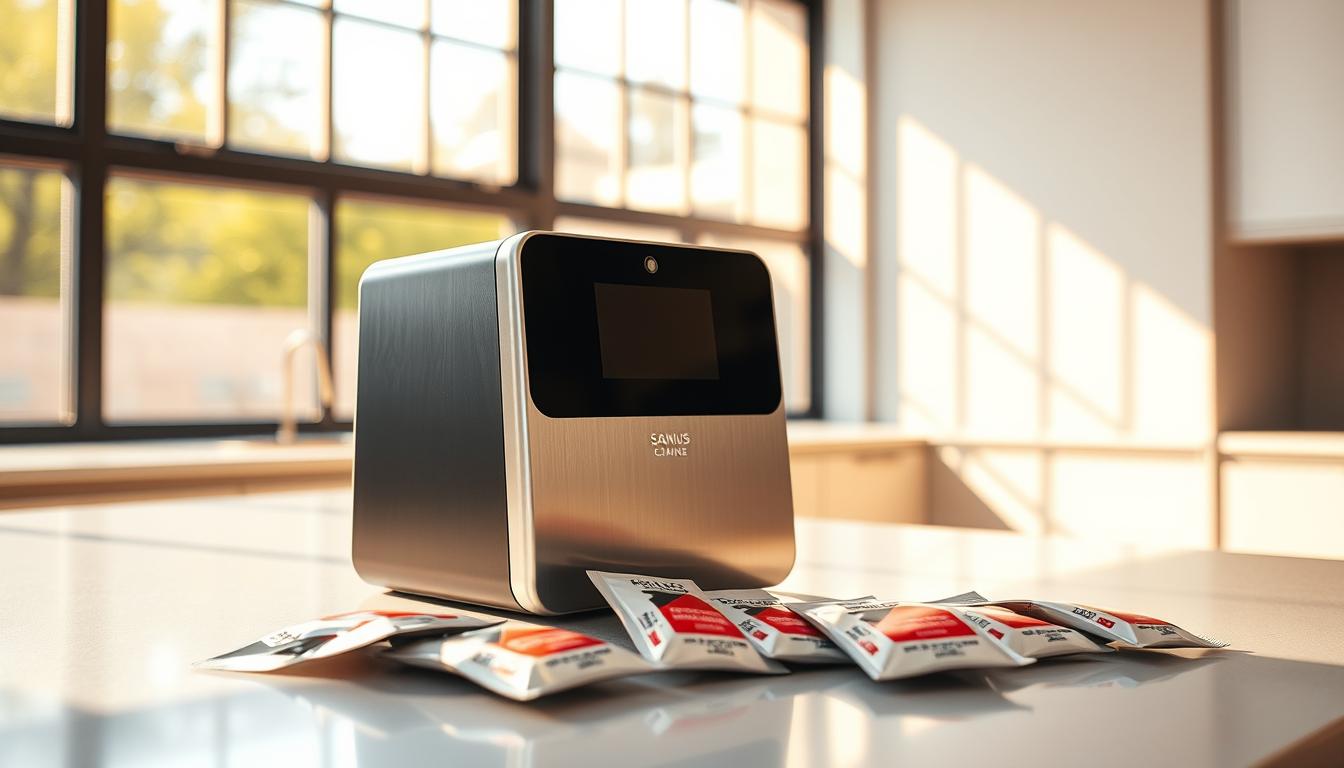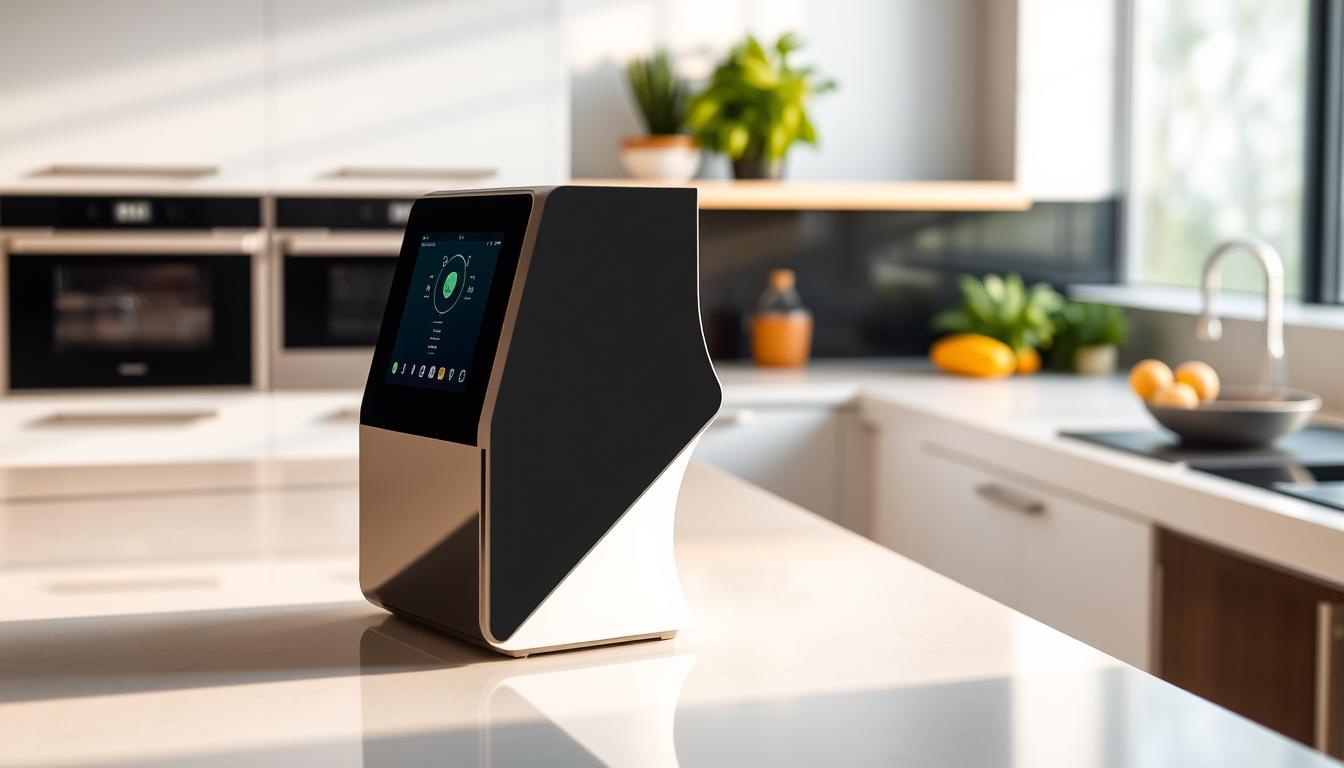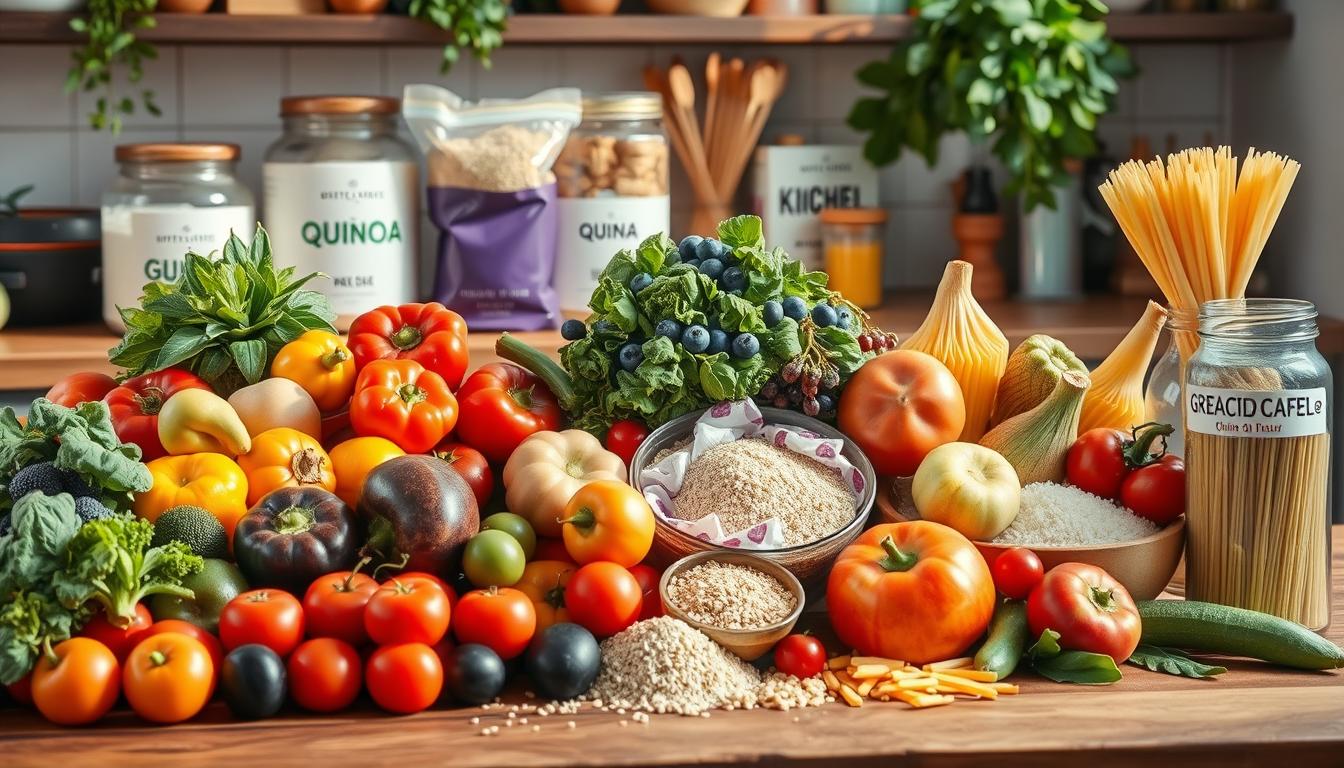Learn how to read ingredient labels for food allergies while shopping with our expert guide. Download Food Scan Genius app for iOS & Android today! 📱 https://food.scangeni.us
The app that people with Food Allergies have been waiting for!
Living with a food allergy can be tough. It’s about checking labels and worrying about cross-contact. But, you’re not alone! We’re here to help you navigate allergens with confidence. Our guide is here to make things easier. The FDA’s strict labeling rules mean you can trust products. But, we know it’s more than just labels—it’s about feeling safe. Introducing the Food Scan Genius app, your AI assistant for dietary needs. It’s on iOS and Android. Scan products, get allergen info, and shop with ease. It’s like having a friend in your pocket! Key Takeaways Our guide simplifies allergen awareness and offers practical tips for everyday life. The FDA enforces strict labeling laws to help you identify allergens in products. The Food Scan Genius app is a must-have tool for managing dietary needs. Allergic reactions can be serious, but proper awareness reduces risks. You’re part of a supportive community that cares about your well-being. Understanding the Importance of Ensuring Safe Food Choices for Allergies Life with dietary restrictions can seem like a maze. But, with the right tools and knowledge, you can make safe choices. Let’s explore why allergen awareness is key and how it empowers you to manage your diet. The Rising Need for Allergen Awareness About 8% of children and 4% of adults in the U.S. have food allergies. This number is growing. Knowing what’s in our food is crucial, especially for common allergens like milk, egg, and wheat. The FDA’s labeling laws help a lot. But, cross-contact can still be a risk. Always read labels carefully and ask questions when eating out. User Intent Behind Allergy-Safe Food Choices People with dietary restrictions want peace of mind. Knowing a product is safe can make a big difference. Here’s what drives their choices: Transparency: Clear labeling avoids guesswork. Safety: Avoiding cross-contact ensures safe meals. Empowerment: Knowing ingredients lets people make confident choices. By staying informed, you can enjoy meals without worry. It’s not just about what you eat—it’s about how you approach your dietary needs. Using the Food Scan Genius App for Allergy-Friendly Shopping Shopping with dietary restrictions just got easier. The Food Scan Genius app makes reading labels simple. It’s perfect for planning meals or quick snacks. This app is your go-to for safe choices. How the AI Assistant Enhances Food Safety Ever wondered if that granola bar is safe for your child? The app’s AI assistant scans product labels in seconds. It flags hidden allergens like peanuts, milk, or soy. It’s like having a personal shopper who knows your dietary needs inside out. Plus, it cross-checks FDA-approved allergen lists, so you can trust the results. Families love how the app simplifies meal planning. One user shared, “It’s a lifesaver for my son with multiple allergies. We can finally enjoy grocery shopping again!” With every step guided by the app, risky exposures are minimized. This even prevents severe reactions like anaphylaxis. Access on iOS and Android Platforms No matter your device, the Food Scan Genius app has you covered. Available on both iOS and Android, it’s designed for seamless use. Just download, set up your profile, and start scanning. The app’s intuitive interface makes it easy for everyone. From tech-savvy teens to busy parents. With features like personalized recommendations and unlimited scans (in the premium version), it’s no wonder 85% of users feel more confident about their food choices. So, why stress over labels when the Food Scan Genius app can do the heavy lifting for you? Navigating FDA Guidelines and Allergen Regulations The FDA plays a crucial role in keeping our meals free from hidden allergens. Their strict rules and inspections help protect consumers from undeclared ingredients like peanuts, tree nuts, and soy. Let’s explore how these regulations work and why they matter. Key Regulatory Actions and Inspections The FDA enforces the Current Good Manufacturing Practice (CGMP) and Preventive Controls (PC) rules to minimize allergen cross-contact. Routine inspections ensure manufacturers follow these guidelines. When violations occur, the FDA takes action—like issuing warning letters or recalling products. For example, in 2023, nearly half of all recalls were due to undeclared allergens. This highlights the importance of strict oversight. By catching issues early, the FDA helps prevent serious reactions to ingredients like tree nuts or peanuts. Accurate Allergen Labeling Clear labeling is a cornerstone of FDA regulations. The Food Allergen Labeling and Consumer Protection Act (FALCPA) requires products to list major allergens like soy, milk, and wheat. This helps consumers make informed decisions about every dish they prepare or consume. Here’s how the FDA ensures accuracy: Routine Inspections: Manufacturers are checked for compliance with labeling laws. Warning Letters: Companies that fail to disclose allergens receive formal warnings. Product Recalls: Items with undeclared allergens are removed from shelves immediately. By following these steps, the FDA reassures consumers that their meals are safe and free from hidden risks. Whether it’s a snack or a full dish, accurate labeling is your best defense against allergens. Practical Tips for Safe Meal Planning and Substitutions Meal planning with dietary restrictions doesn’t have to be stressful—let’s make it simple! With a little creativity and the right strategies, you can enjoy delicious meals without worry. Here’s how to take control of your kitchen and create dishes that work for you. Identifying and Avoiding Common Allergens First, learn about common allergens. Look out for sesame, fish, and wheat. Always check labels for hidden names like “tahini” for sesame or “albumin” for eggs. If unsure, ask or choose products with clear allergen statements. Here’s a quick guide to substitutions: Milk: Try almond, oat, or rice milk for a creamy alternative. Eggs: Use applesauce or mashed bananas in baking. Peanuts: Swap in sunflower or oat butter for a nut-free spread. Fish: Opt for chicken, tofu, or jackfruit in recipes. Managing Your Kitchen for Safety Prevent cross-contamination by organizing your kitchen. Use separate cutting boards and utensils for allergen-free cooking. Label containers clearly and store allergens in a designated area. This saves time and reduces risks. Meal prep is a
Scan Food for Allergens Quickly & Safely
Learn how to scan food for allergens effectively with reliable tools and apps that help identify potentially dangerous ingredients. Stay safe while dining out or grocery shopping
Discover Your Food Allergies with Our Accurate Scanner
Protect your health with our advanced food allergy scanner that instantly detects allergens in meals. Get accurate results and peace of mind when dining at home or restaurants
How To Spot Milk Ingredients To Avoid While Grocery Shopping
Navigating a milk allergy can feel overwhelming, especially when shopping for groceries. With so many products on the shelves, it’s crucial to know what to avoid. This guide will help you identify common milk-derived ingredients, read labels effectively, and make informed choices, ensuring you stay safe while enjoying your favorite foods. Let’s dive in! Table Of Contents Understanding Milk Allergies Common Milk-Derived Ingredients to Avoid How to Read Food Labels for Milk Allergens Supermarket Shopping Tips for Milk Allergy Management Trusted Resources and Tools for Milk Allergy Management Practical Advice for Families Managing Milk Allergies Conclusion Related Posts Frequently Asked Questions (FAQs) Sources Key Takeaways Understanding the difference between a milk allergy and lactose intolerance is crucial for proper management and treatment. Always read food labels carefully, looking for both obvious and hidden milk-derived ingredients to avoid allergic reactions. Familiarize yourself with the Food Allergen Labeling and Consumer Protection Act (FALCPA) to better navigate food packaging and allergen disclosures. Explore safe food alternatives, such as plant-based milk options, to maintain a balanced diet while avoiding milk allergens. Educate and empower children with milk allergies to make safe food choices, fostering independence and confidence in their dietary management. Understanding Milk Allergies What is a Milk Allergy? A milk allergy is a type of food allergy where your immune system reacts negatively to proteins found in milk, most commonly casein and whey. Unlike lactose intolerance, which is a digestive issue, a milk allergy can trigger serious immune responses, including hives, swelling, or even anaphylaxis. It’s one of the most common food allergies, especially in children, though some adults experience it too. If you’re managing a milk allergy, tools like Food Scan Genius can help you identify hidden milk ingredients in products. Their platform simplifies label reading and ensures you avoid risky items while shopping. Symptoms and Diagnosis of Milk Allergies Milk allergy symptoms can vary from mild to severe. Common signs include skin reactions like rashes or hives, stomach issues such as cramps or vomiting, and respiratory problems like wheezing. In severe cases, exposure to milk proteins can lead to anaphylaxis, a life-threatening reaction requiring immediate medical attention. Diagnosing a milk allergy typically involves a combination of medical history, skin prick tests, and blood tests. Your doctor may also recommend an elimination diet to confirm the allergy. For more detailed guidance, check out resources like the Cleveland Clinic’s milk allergy page or Johns Hopkins Medicine. Understanding your symptoms and getting a proper diagnosis is the first step toward managing a milk allergy effectively. With the right tools and knowledge, like those offered by Food Scan Genius, you can confidently navigate your dietary restrictions and make safe choices. Common Milk-Derived Ingredients to Avoid Major Milk Ingredients Found in Products When managing a milk allergy, it’s essential to recognize the obvious culprits. Ingredients like milk, cream, butter, cheese, and yogurt are straightforward to spot. However, milk proteins such as casein and whey are also common in many products, including baked goods, protein powders, and even some candies. To make shopping easier, tools like Food Scan Genius can help you quickly identify these ingredients. Their platform scans product labels and flags milk-derived components, saving you time and stress. For a deeper dive into ingredient transparency, check out this guide to understand what’s really in your food. Hidden Milk Ingredients in Processed Foods Milk-derived ingredients often hide under less obvious names in processed foods. Terms like “lactose,” “caseinate,” “ghee,” and “hydrolyzed whey protein” can indicate the presence of milk. Additionally, processed meats, salad dressings, and even some non-dairy creamers may contain milk derivatives. Reading labels carefully is crucial, but it can be overwhelming. That’s where Food Scan Genius comes in handy. Their database helps you uncover hidden milk ingredients in everyday products, ensuring you avoid accidental exposure. For more tips on identifying hidden allergens, explore this resource. With the right knowledge and tools, you can confidently navigate the supermarket and keep your diet safe. How to Read Food Labels for Milk Allergens Understanding the Food Allergen Labeling and Consumer Protection Act (FALCPA) The Food Allergen Labeling and Consumer Protection Act (FALCPA) is a game-changer for anyone managing food allergies. This law requires manufacturers to clearly label the presence of major allergens, including milk, on packaged foods. If a product contains milk or milk-derived ingredients, it must be listed in plain language, either in the ingredient list or in a “Contains” statement. For example, a product might say “Contains: Milk” or list ingredients like “casein (milk)” to make it clear. This transparency helps you make safer choices while shopping. Tools like Food Scan Genius can further simplify this process by scanning labels and identifying allergens for you. Tips for Identifying Milk Ingredients on Labels Even with FALCPA, milk ingredients can sometimes be tricky to spot. Look out for terms like “whey,” “casein,” “lactose,” and “milk solids.” Some less obvious culprits include “nougat,” “ghee,” and “hydrolyzed protein.” Always double-check labels, especially on processed foods, as recipes can change without notice. To make this easier, consider using Food Scan Genius. Their platform helps you decode complex ingredient lists and flags hidden milk allergens. For additional guidance, explore this resource to deepen your understanding of food allergens. By staying vigilant and using the right tools, you can confidently navigate food labels and avoid milk allergens, ensuring your safety and peace of mind. Supermarket Shopping Tips for Milk Allergy Management Safe Food Alternatives for Milk Allergies Finding safe alternatives is key when managing a milk allergy. Thankfully, there are plenty of options available. Look for plant-based milk like almond, soy, oat, or coconut milk. Vegan butter, cheese, and yogurt are also great substitutes. Many brands now offer dairy-free versions of popular products, making it easier to enjoy your favorite foods without the risk. To simplify your search, Food Scan Genius can help you identify safe alternatives. Their platform scans product labels and highlights options that are free from milk allergens. For more insights, check out this guide on vegan ingredients.
How To Shop Safely With Peanut Allergies – Your Essential Guide
How To Shop Safely With Peanut Allergies – Your Essential Guide Navigating grocery stores can be tricky if you have a peanut allergy. With so many products and labels to sift through, it’s easy to feel overwhelmed. But don’t worry! This guide will help you shop safely and confidently, ensuring you find delicious options without the worry of allergens. Let’s dive in and make your shopping experience stress-free! Table Of Contents Understanding Peanut Allergies Preparing for a Safe Shopping Experience Reading Food Labels Effectively Conclusion Related Posts Frequently Asked Questions (FAQs) Key Takeaways Understanding peanut allergies is crucial for identifying safe food options and recognizing potential symptoms. Always read food labels carefully, looking for allergen warnings and ingredient lists to avoid accidental exposure. Research brands and products ahead of time to find safe alternatives that suit your dietary needs. Create a shopping checklist to streamline your grocery trips and ensure you don’t miss any safe products. Utilize tools and apps designed to help with label reading and allergen identification for a more efficient shopping experience. Understanding Peanut Allergies What Are Peanut Allergies? Peanut allergies are one of the most common food allergies, affecting millions of people worldwide. They occur when your immune system mistakenly identifies peanut proteins as harmful, triggering an allergic reaction. Even a tiny amount of peanuts can cause a response, making it crucial to avoid them entirely. Peanut allergies can develop at any age, though they often appear in childhood and may persist for life. If you’re unsure whether a product contains peanuts, tools like Home – Food Scan Genius can help. This AI-powered assistant scans product labels and identifies allergens, making shopping safer and easier. It’s a game-changer for anyone managing food allergies. Symptoms and Risks of Peanut Allergies Symptoms of peanut allergies can range from mild to severe. Mild reactions might include itching, hives, or a runny nose. However, severe reactions, such as anaphylaxis, can be life-threatening. Anaphylaxis may cause difficulty breathing, swelling, a drop in blood pressure, or even loss of consciousness. If you suspect an allergic reaction, seek medical attention immediately. To minimize risks, always read food labels carefully. Look for terms like “may contain peanuts” or “processed in a facility with peanuts.” The FDA’s Food Allergen Labeling and Consumer Protection Act (FALCPA) requires manufacturers to clearly label major allergens, including peanuts. For added peace of mind, consider using tools like Food Scan Genius. It simplifies the process by scanning barcodes and flagging potential allergens, helping you shop with confidence. Preparing for a Safe Shopping Experience Researching Brands and Products Before heading to the store, take some time to research brands and products that are safe for those with peanut allergies. Many companies now offer allergen-free product lines, and knowing which brands to trust can save you time and stress. Start by visiting brand websites or checking allergen-friendly databases like Food Scan Genius. This tool allows you to scan product barcodes and instantly identify potential allergens, making it a must-have for safe shopping. Additionally, look for brands that specialize in allergen-free foods. Websites like Snack Safely provide detailed lists of peanut-free snacks and products. Bookmark these resources for quick access when planning your shopping trip. Creating a Shopping Checklist A well-prepared shopping checklist can make your trip to the store more efficient and less stressful. Start by listing the items you need, and note any specific brands or products you’ve researched as safe. Include categories like snacks, pantry staples, and fresh produce to ensure you don’t miss anything. For added convenience, use apps like Food Scan Genius to create a digital checklist. This app not only helps you organize your shopping but also flags any items that may contain peanuts or other allergens. It’s a great way to stay organized and confident while shopping. By researching ahead of time and creating a detailed checklist, you’ll be better prepared to navigate the grocery store safely and efficiently. Reading Food Labels Effectively Decoding Food Labels for Peanut Allergies Reading food labels is a critical skill when managing peanut allergies. It might seem overwhelming at first, but with a little practice, you’ll become a pro at spotting potential allergens. Start by looking for the “Contains” statement, which is required by the FDA to list major allergens like peanuts. For example, a label might say, “Contains: Peanuts.” This is your first red flag. Next, check the ingredient list for hidden sources of peanuts. Ingredients like “peanut oil,” “groundnuts,” or “arachis oil” are all peanut derivatives. Be cautious of terms you don’t recognize—when in doubt, research them or avoid the product altogether. Some labels also include a “May Contain” or “Processed in a Facility” statement. While these are voluntary, they indicate potential cross-contamination risks. If you see these warnings, it’s best to steer clear. Tools to Simplify Label Reading To make label reading easier, consider using tools like Food Scan Genius. This app scans product barcodes and flags any allergens, saving you time and reducing stress. It’s especially helpful for deciphering complex ingredient lists. Another great resource is the Allergy Eats website, which provides user reviews of allergen-friendly products and restaurants. Combining these tools with your label-reading skills ensures a safer shopping experience. By staying vigilant and using the right resources, you can confidently navigate food labels and make informed choices for your peanut-free lifestyle. Conclusion Shopping with a peanut allergy doesn’t have to feel like navigating a minefield. By understanding your allergy, preparing ahead of time, and mastering the art of reading food labels, you can confidently fill your cart with safe and delicious options. Remember, knowledge is your best ally—knowing what to look for and how to avoid potential risks is key to a stress-free shopping experience. One of the most important takeaways is to always double-check product labels and stay informed about cross-contamination risks. Creating a shopping checklist and researching allergy-friendly brands can save you time and worry. And don’t forget, there are tools out there to make this process even easier. Speaking of
Analyze Artificial Sweeteners Quickly with Our New Scanner
Discover hidden artificial sweeteners in your food with our innovative artificial sweetener scanner. Make informed choices about your diet and protect your health instantly
Top-Rated Sugar-Free Scanner: Effortless Cooking Companion
Discover the ultimate sugar-free scanner that helps you make healthier food choices. Find hidden sugars in products, track ingredients, and enjoy peace of mind while shopping and cooking
30 Easy Vegan Recipes for Beginners | Plant-Based Meals
Discover delicious vegan recipes perfect for beginners. Learn to cook plant-based meals with simple ingredients and step-by-step instructions. Transform your diet today
Complete Guide to a Gluten-Free Diet: What You Need to Know
Starting a gluten-free journey can feel both exciting and scary. But, with the right help, you can find your way easily. Let’s explore the world of gluten-free living together. You’ll discover its benefits and how it can help you be your best self. Ever thought a gluten-free diet plan could improve your health? It’s not just for those with celiac disease. This guide will teach you how to make smart choices for your health. Key Takeaways Understand the basics of gluten and its health effects Find out where gluten hides and how to avoid it Discover tasty, healthy alternatives to your favorite foods Learn to read labels and shop for gluten-free items Enjoy eating out without worrying about gluten Understanding Gluten and Its Effects on Health Dealing with dietary restrictions can be tough. But knowing about gluten and its health effects is key. Non-celiac gluten sensitivity is a growing concern. It’s when people react badly to gluten but don’t have celiac disease. Learning about gluten and its health impacts helps us make better diet choices. What Is Gluten and Where Is It Found? Gluten is a protein in grains like wheat, barley, and rye. It makes food elastic and holds things together. Gluten is in many foods, but also in sauces, condiments, and some meds. Knowing where gluten is helps those on a gluten-free diet plan. Health Conditions Related to Gluten Sensitivity Celiac disease: An autoimmune disorder where gluten damages the small intestine. Non-celiac gluten sensitivity: Digestive issues, fatigue, and other symptoms from gluten, without celiac disease. Wheat allergy: An allergic reaction to wheat proteins, causing symptoms like hives and swelling. Signs and Symptoms of Gluten Intolerance Knowing the signs of gluten intolerance is important. Symptoms include bloating, pain, diarrhea, and fatigue. Headaches and skin rashes can also happen. Paying attention to how you feel after eating gluten is key. Understanding the nuances of gluten sensitivity is key to managing our health and maintaining a balanced, nutritious diet. Getting Started with a Gluten-free Diet Plan Starting a gluten-free diet plan can seem tough at first. But don’t worry, we’re here to help. We’ll guide you through the first steps to make it easy and stress-free. First, fill your pantry with gluten-free basics. You’ll need things like gluten-free alternatives like rice, quinoa, and gluten-free oats. Always check labels to make sure they’re gluten-free. Now, let’s plan your first gluten-free meals. Focus on fresh, whole foods for the best nutrition. Aim for balanced meals with lean proteins, veggies, and healthy fats. There are many tasty gluten-free alternatives out there. Make shopping easier by downloading the Food Scan Genius app. It lets you scan barcodes to find gluten-free products quickly. It’s like having a gluten-free guide in your pocket! “Transitioning to a gluten-free diet can feel overwhelming, but with the right tools and information, it can be a truly empowering experience.” Adjusting to gluten-free might take a few weeks. But the benefits, like better digestion and more energy, are worth it. Let’s start this journey together and make it easy for you. Essential Foods to Avoid on a Gluten-free Diet Starting a gluten-free diet can seem hard, but knowing what to avoid makes it easier. We’ll look at hidden gluten sources, key ingredients to watch, and how to avoid cross-contamination. Hidden Sources of Gluten Gluten hides in many places, so always check labels. It’s in soy sauce, salad dressings, and even flavored coffee creamers. Processed meats, licorice, candies, and some meds can also have gluten. Common Gluten-Containing Ingredients Wheat, barley, rye, and their derivatives Malt, including malt vinegar and malt flavoring Semolina, bulgur, and couscous Breadcrumbs, croutons, and stuffings Soy sauce, teriyaki sauce, and other condiments Cross-Contamination Risks To keep your diet safe, watch out for cross-contamination. This happens when gluten foods touch gluten-free ones. Shared tools, cutting boards, and oil can all cause gluten exposure. Potential Sources of Cross-Contamination Preventive Measures Shared kitchen equipment Dedicated gluten-free cookware and utensils Communal condiment containers Individual, sealed condiment packets Unclean food preparation surfaces Thorough cleaning and sanitization By knowing where gluten hides, avoiding common ingredients, and preventing cross-contamination, you can enjoy a gluten-free lifestyle. It’s safe and fulfilling. Safe and Nutritious Gluten-free Alternatives Going gluten-free doesn’t mean you have to give up taste or nutrition. There are many tasty and healthy gluten-free options out there. You can find them in grains, flours, snacks, and baked goods. Here are some tasty gluten-free alternatives to try: Quinoa: A versatile, protein-packed grain that can be used in salads, pilafs, and even as a flour substitute. Brown rice flour: A great all-purpose flour alternative that works well in baking and thickening sauces. Almond flour: High in protein and healthy fats, almond flour is a nutritious choice for baked goods. Coconut flour: Packed with fiber and low in carbs, coconut flour is a fantastic option for gluten-free baking. Lentil pasta: Legume-based pastas offer a protein-rich and fiber-filled alternative to traditional wheat-based pasta. For snacks and baked goods, there are many gluten-free products available. You can find everything from crackers and chips to cookies and breads. These alternatives are not only tasty but also packed with nutrients like protein, fiber, and healthy fats. Gluten-free Alternative Nutritional Benefits Quinoa High in protein, fiber, and essential vitamins and minerals Almond flour Rich in healthy fats, protein, and antioxidants Lentil pasta Provides a good source of plant-based protein and fiber By trying these gluten-free alternatives, you can enjoy your favorite foods while staying healthy. With a bit of creativity, you’ll find a world of delicious and nutritious gluten-free options. Reading Labels and Shopping Tips for Gluten-free Products Shopping for gluten-free food can seem hard. But we’re here to help! We’ll teach you how to read labels, understand gluten-free labels, and use the Food Scan Genius app. We’ll also share ways to shop without spending too much. Understanding Certification Labels When you’re looking for gluten-free food, check for trusted labels. Look for the Gluten-Free Certification Organization (GFCO) and the Celiac Support Association (CSA) seals.

